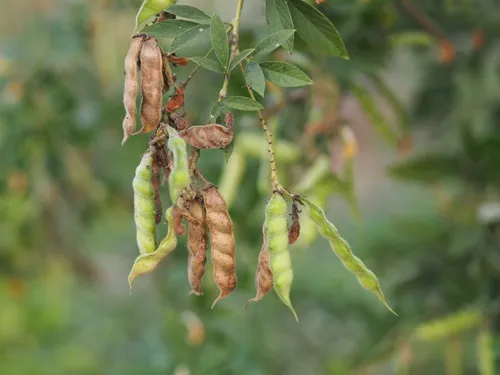 ਵਾਪਸ
ਵਾਪਸ

Introduction
Introduction
Soybeans are the world’s foremost provider of primary protein and secondarily oil. This crop is extensively cultivated in Maharashtra, Madhya Pradesh and Telangana states. Soybean plant health is a critical component of profitable soybean production. Over a hundred plant diseases caused by viruses, fungi, bacteria, and non-infectious agents are known to affect soybeans. About 67 or more virus diseases have been reported to infect soybeans worldwide, of which 27 viral diseases are considered to be a threat to soybean cultivation. Recently the viral diseases which cause economic losses in soybean are Soybean mosaic virus is found in many parts

What is Soybean mosaic virus (SMV)
What is Soybean mosaic virus (SMV)
It is the most prevalent virus and is recognized as the most serious, long-standing problem in many soybean-producing areas in India and some parts of Maharashtra. Infection by SMV usually results in severe yield losses (8 to 50%) and seed quality reduction.


Which are the Host crop range
Which are the Host crop range
SMV has a relatively narrow host range, infecting six plant families, Fabaceae, Amaranthaceae, Chenopodiaceae, Passifloraceae, Scrophulariaceae, and Solanaceae, but mostly the Leguminosae including soybean and its wild relatives.
Symptoms
Symptoms
In SMV-infected soybeans symptoms commonly observed include dark green vein banding and light green inter-veinal areas, stunting, leaf curling, and seed coat mottling, necrosis, sometimes necrotic local lesions, systemic necrosis, and bud blight.


How SMV virus Transmit
How SMV virus Transmit
About 30% or more of the seeds from SMV-infected soybean plants carry SMV depending on the cultivar and time of infection before flowering. Weeds and other plants may also serve as a reservoir for SMV. Further spread within and among soybean fields is through the aphid species.


Some of the management practices suggested by the Directorate of Agriculture New Delhi and Soyabean research station Madhya Pradesh.
Some of the management practices suggested by the Directorate of Agriculture New Delhi and Soyabean research station Madhya Pradesh.
1 Regular awareness and training to the farmers as a mass campaign be conducted. 2. Monitoring and management of white flies on alternate hosts like summer moong etc. 3. Use of resistant varieties viz. PS 1042, PS 1347, PS 1368, PS 1092, PS 1225, Pusa 97 & Pusa 12 for Northern Plain zone; JS 20-29, JS 20-69, JS 97-52 & RKS 24 for Central zone; PS 1029 for Southern zone and JS 97-52 for Northeastern zone.


- Ensure timely sowing of crop e.g., 15-30 June for Northeastern & Southern zone; 20 June-5 July for Northern Plain and Central zone. 5. Optimum plant population with 24-30 kg/ha seed rate and 45x5 cm spacing. 6. Seed treatment with recommended fungicide followed by treatment with Thiamethoxam 30 FS @10 ml/kg seed or imidacloprid 48 FS @1 .24 ml/kg seed and inoculation.


- Apply a recommended dose of fertilizer and Farmyard manure for good crop growth. 8. Keep the field weed-free up to 45 days after sowing. 9. Removal and destruction of infested plants showing virus symptoms.




- Spray on standing crop with recommended chemicals like Confidor to control aphids 11. It is also advised to spray the crop with Soloman (Betacyfluthrin + Imidacloprid) 140 ml/acre ). These chemicals are also useful for the control of stem fly infestation. 12. Use yellow sticky traps (20-25 traps/ha) to trap adult white flies.


Thank you for reading this article, we hope you clicked on the ♡ icon to like the article and also do share it with your friends and family now!








